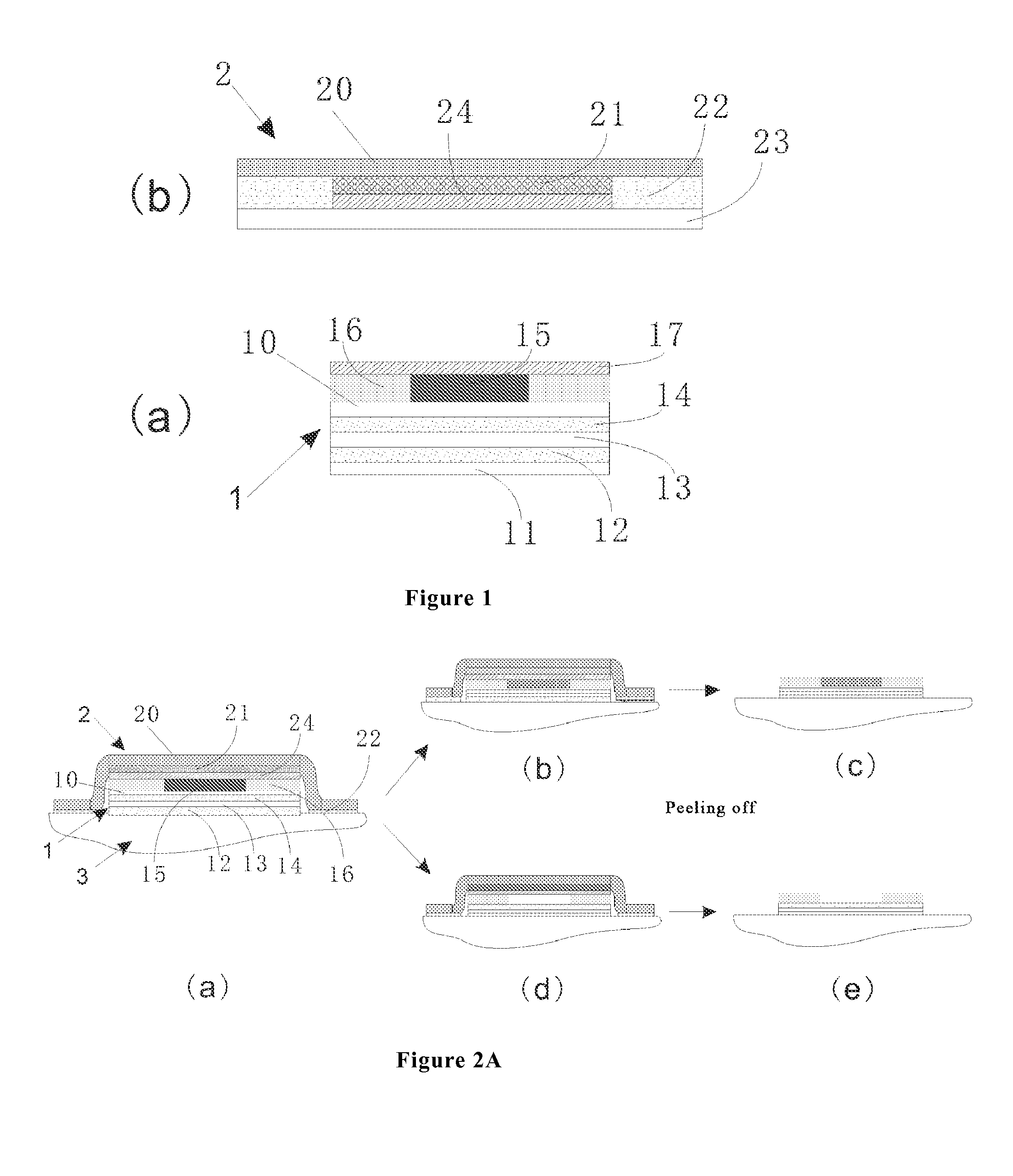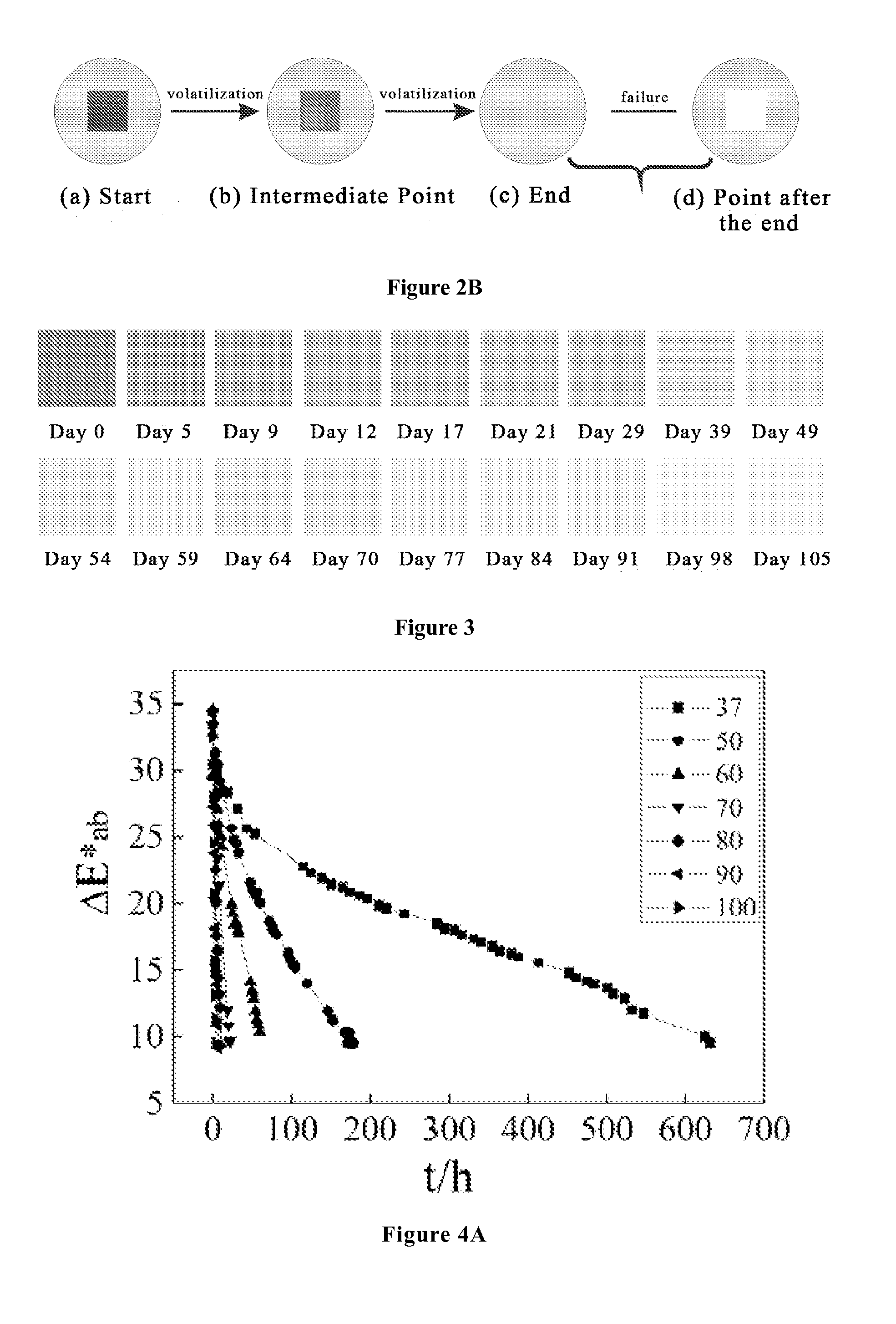Time-temperature indicator and monitoring method for monitoring quality state of thermally sensitive article
a technology of temperature-sensitive articles and indicators, which is applied in the direction of heat measurement, paper/cardboard containers, instruments, etc., can solve the problems of bioactive samples and the like which need low temperature storage, deterioration, failure or loss of activity during storage or transportation, and often exceed the safe storage and transportation temperature for a long time. , to achieve the effect of shortening the time to fail or deteriorate, increasing the volatilization rate and increasing the quality deterioration ra
- Summary
- Abstract
- Description
- Claims
- Application Information
AI Technical Summary
Benefits of technology
Problems solved by technology
Method used
Image
Examples
example 1
[0254]Dye A is used as the volatile dye of the time-temperature indicator, and 2% of dye A is quantitatively printed on normal A4 paper (the solvent is ethyl acetate, the coating amount of dye A is about 200 μg per square centimeter) to form an indication function layer; commercial available adhesive paper which can effectively adsorb dye A is placed above dye A, and the adhesive faces to the dye layer to form an adsorption function layer; the indication function layer and the adsorption function layer are further sealed with a sealing film which is not permeable, and the sealed sample is kept at a constant temperature of 25° C. After standing for a certain time, the colour of the indicator is observed and recorded. FIG. 3 is the colour record of an indicator which has been kept at a constant temperature of 25° C. for 0-105 days. After dye A has completely volatilized, there is not any trace of the dye remaining under naked eyes, and the functional position of the indication almost ...
example 2
[0255]FIGS. 4A and 4B show the change the colour difference ΔE*ab of a time-temperature indicator produced with dye A as the volatile dye according to the method in example 1 over time t at different temperatures. The colour change time and rate of this indicator can be calculated with the colour difference ΔE*ab=10 as the end of the colour change, and the activation energy of the change process thereof can be further deduced as 97.4 kJ / mol (FIG. 5) from the Arrhenius equation, so as to obtain the characterization parameter of the temperature effect of the colour change process of the indicator. This activation energy can cover very well the activation energy range of 73.6-109 kJ / mol in which the literatures report that the polio vaccines are inactivated, and can also cover the activation energy range in which some other vaccines are inactivated.
[0256]FIG. 6 shows a tag designed for a hepatitis B vaccine with dye A, and the colour change response of the TTI of the present invention ...
example 3
[0257]The total time of the colour change of the indicator can be adjusted by adjusting the amount of the volatile dye printed per unit area at the functional indication position of the indicator, which can be adjusted by adjusting the inking amount or the concentration of the ink during the printing.
[0258]FIG. 7 shows the initial colour difference of an indicator and the colour change process at the same temperature, wherein the indicator is obtained with dye A as the volatile dye through using different concentrations of the ink and the same inking amount according to the method in example 1. The time which the indicator spends to reach the end is in linear relation with the amount of the volatile dye printed per unit area (FIG. 8).
PUM
| Property | Measurement | Unit |
|---|---|---|
| activation energy | aaaaa | aaaaa |
| activation energy | aaaaa | aaaaa |
| temperature | aaaaa | aaaaa |
Abstract
Description
Claims
Application Information
 Login to View More
Login to View More - R&D
- Intellectual Property
- Life Sciences
- Materials
- Tech Scout
- Unparalleled Data Quality
- Higher Quality Content
- 60% Fewer Hallucinations
Browse by: Latest US Patents, China's latest patents, Technical Efficacy Thesaurus, Application Domain, Technology Topic, Popular Technical Reports.
© 2025 PatSnap. All rights reserved.Legal|Privacy policy|Modern Slavery Act Transparency Statement|Sitemap|About US| Contact US: help@patsnap.com



